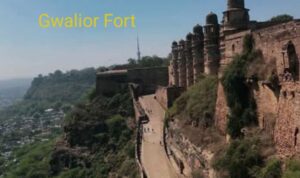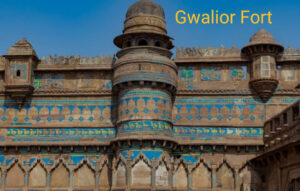Gwalior Fort, often referred to as the “Gibraltar of India,” is a majestic fortress perched atop a hill in Gwalior, Madhya Pradesh. This iconic structure is renowned for its architectural brilliance and rich historical significance. Standing as a symbol of India’s glorious past, Gwalior Fort attracts history enthusiasts and tourists alike, eager to explore its grandeur and legacy.

1. Gwalior Fort: Historical Background
The origins of Gwalior Fort trace back to the 6th century, though legends suggest it may be even older. According to local lore, the fort was established by Suraj Sen, a local ruler who was cured of leprosy by the hermit saint Gwalior , after whom the fort is named. Over centuries, the fort has seen numerous rulers, including the To Mars , Mughals, Marathas, and the British, each leaving their mark on its structure and history. Significant events such as battles, sieges, and royal successions have unfolded within its walls, shaping the course of Indian history.
2.Gwalior Fort: Architectural Marvels
Gwalior Fort is an architectural wonder, showcasing a blend of Hindu and Islamic styles. The fort complex is home to a variety of structures, including palaces, temples, and water tanks, each featuring intricate designs and detailed carvings. The fort’s expansive walls, stretching over 2.4 kilometers, are an engineering marvel, designed to withstand sieges and invasions. The artistry and craftsmanship of the era are evident in the ornate decorations and majestic facades of the fort’s buildings.

3.Gwalior Fort: Notable Structures
• Man Singh Palace
One of the most prominent structures within Gwalior Fort is the Man Singh Palace. Built by Raja Man Singh Tomar in the 15th century, this palace is a prime example of Hindu architecture. Its vibrant tiles, ornate decorations, and strategic location offer a glimpse into the opulence of the Tomar dynasty.
• Gujari Mahal
Gujari Mahal, constructed by Raja Man Singh for his beloved queen Mrignayani, stands as a symbol of love and devotion. Today, it has been converted into an archaeological museum, housing a vast collection of artifacts, sculptures, and ancient relics.
• Sas-Bahu Temples
These twin temples, dedicated to Lord Vishnu, are masterpieces of intricate design and craftsmanship. The name “Sas-Bahu” (Mother-in-law and Daughter-in-law) is derived from the smaller and larger temple structures. These temples are renowned for their elaborate carvings and artistic elegance.
• Teli Ka Mandir
The Teli Ka Mandir, or the Oilman’s Temple, is the tallest and most unique temple within the fort complex. Its architecture is a fascinating amalgamation of Dravidian and North Indian styles, featuring a towering shikhara and ornate decorations.
4.Legends and Myths
Gwalior Fort is steeped in legends and myths that add to its allure. One popular legend is about the hermit saint Gwalior , who is believed to have blessed Suraj Sen and bestowed the name “Gwalior” upon the fort. Local folklore also speaks of hidden treasures and secret tunnels within the fort, adding an air of mystery to its historical narrative.

5. Tourist Information
Visiting Gwalior Fort is a journey through time, offering a glimpse into India’s royal past. Here are some essential tips for tourists:
• Best Time to Visit
The ideal time to visit Gwalior Fort is during the winter months, from October to March, when the weather is pleasant and suitable for exploring the fort’s vast expanse.
• How to Reach Gwalior Fort
Gwalior is well-connected by road, rail, and air. The fort is easily accessible from the city center, with various modes of transport available, including taxis, auto-rickshaws, and buses.
• Nearby Attractions and Accommodations
Gwalior Fort is surrounded by several other attractions, such as the Jai Vilas Palace, Sun Temple, and the Scindia Museum. The city offers a range of accommodation options, from budget hotels to luxury resorts, ensuring a comfortable stay for visitors.
• Tips for Visitors
– Wear comfortable footwear as exploring the fort involves a lot of walking.
– Carry water and snacks, especially during the summer months.
– Hire a local guide to gain deeper insights into the fort’s history and architecture.
6.Preservation and Conservation
Preserving Gwalior Fort’s rich heritage is a challenging yet crucial task. Various efforts have been undertaken by the government and heritage conservation organizations to maintain the fort’s structural integrity and historical significance. However, issues such as weathering, vandalism, and inadequate funding pose significant challenges.
Conclusion:
Gwalior Fort is not just a monument; it is a narrative of India’s grand history, architectural brilliance, and cultural heritage. A visit to this fort is a journey back in time, offering a deep dive into the stories of valor, love, and devotion that shaped its existence. For history enthusiasts, architecture lovers, and curious travelers, Gwalior Fort remains an unmissable destination, beckoning with its timeless charm and grandeur.
FAQ:
1.Why is Gwalior Fort famous?
2.Why is Gwalior Fort called Gibraltar of India?
3.Who was the king of Gwalior Fort?
4.How much time does it take to visit Gwalior Fort?
5.Gwalior fort ticket price
6.Gwalior Fort was built by which king
7.Gwalior fort photos
8.Gwalior Fort information
9.5 Lines about Gwalior Fort
10.Gwalior Fort owner


Pingback: Daulatabad Fort Aurangabad : The Best Architectural Marvel Through the Ages - solotraveler
Pingback: Visit Palakkad Fort: A Historic Landmark in the Heart of Kerala - solotraveler